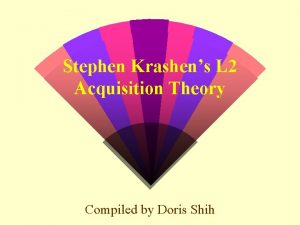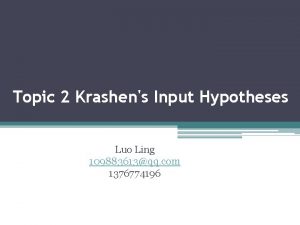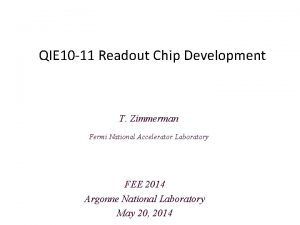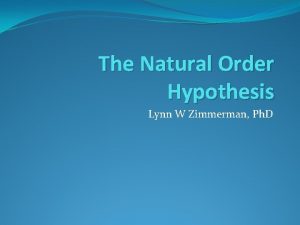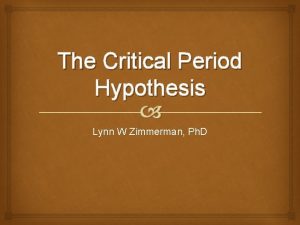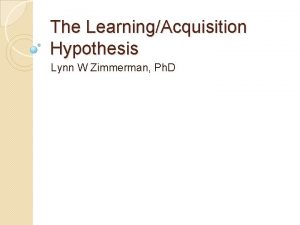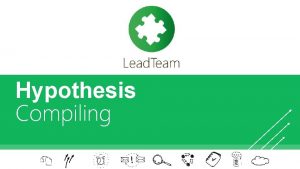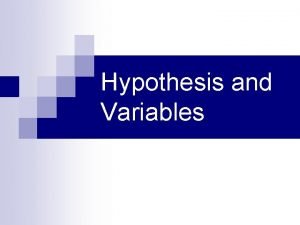The Input Hypothesis Lynn W Zimmerman Ph D











- Slides: 11

The Input Hypothesis Lynn W Zimmerman, Ph. D

How does acquisition take place? Comprehensible input i+1 If too low, nothing new to acquire If too high, not comprehensible Helps the learner focus on meaning not form Besides linguistic competence the learner relies on context and knowledge of the world to help understand language.

Comparing Models Traditional model learn structures, practice them, use them in communication Acquisition model meaning first, structure follows Speaking fluency cannot be taught Related to care-taker speech of first language acquisition

Effective Input Foreigner-talk – modification native speakers make when communicating with language learners uses exaggeration, timing, gestures, simplification, prompting, etc. to be comprehensible Teacher-talk – language of classroom management and instruction provides scaffolding Interlanguage – the learner’s speech

Arguments against a grammatical syllabus All students not at same level Grammatical is presented once Assumes we know the order of acquisition Limits what can be discussed

The Silent Period At the beginning - some memorized language Building up competence through listening and trying to comprehend the language Once some competence has developed, speaking emerges. Rarely error-free. In language classes, no allowance is made for a silent period.

L 1 Rules Advantage Speaker attempts communication allowing more input Disadvantages Monitor may not be able to note and repair all errors caused by this misuse May not help the learner learn or acquire the language

Implications for the Classroom Teacher cannot meet every student’s exact needs. Direct instruction of grammar is not necessary. Strategies Pictures, gestures, tone of voice, hands-on activities Avoid idioms Slower rate of speech Recycle vocabulary Reading, especially free voluntary reading

Critique of The Input Hypothesis Learning and acquisition are not separate Ellis (1984, 1986) and Levelt (1989) – learning and acquisition are part of the same component Mc. Laughlin, Rossman, and Mc. Leod (1984) - a continuum of conscious and unconscious functioning

More Critique Input Hypothesis is not specific in how to define levels of knowledge i + 1 is vague Sufficient comprehensible input What is sufficient? What are the various levels (i)? How does it cause grammar acquisition? Does the quantity necessary for change depend on developmental level or how ready the learner is to acquire a new form? Krashen created circular argumentation by tying the hypotheses together

References Freeman, D. & Freeman, Y. (2014). Essential linguistics. Portsmouth, NH: Heinemann. Gass, S. & Selinker, L. (2008). Second language acquisition. NY: Routledge. Krashen, S. (1981). Principles and practice in second language acquisition. Oxford: Pergamon Press.
 Lynn zimmerman attorney
Lynn zimmerman attorney Piotr zimmerman
Piotr zimmerman Null and alternative hypothesis examples
Null and alternative hypothesis examples Nebular hypothesis and protoplanet hypothesis venn diagram
Nebular hypothesis and protoplanet hypothesis venn diagram Hypotheses in research example
Hypotheses in research example Alternative hypothesis
Alternative hypothesis Krashens monitor model
Krashens monitor model What is input hypothesis
What is input hypothesis Zimmerman telegram political cartoon
Zimmerman telegram political cartoon Janice zimmerman md
Janice zimmerman md Kaylan szafranski
Kaylan szafranski Zimmerman
Zimmerman






